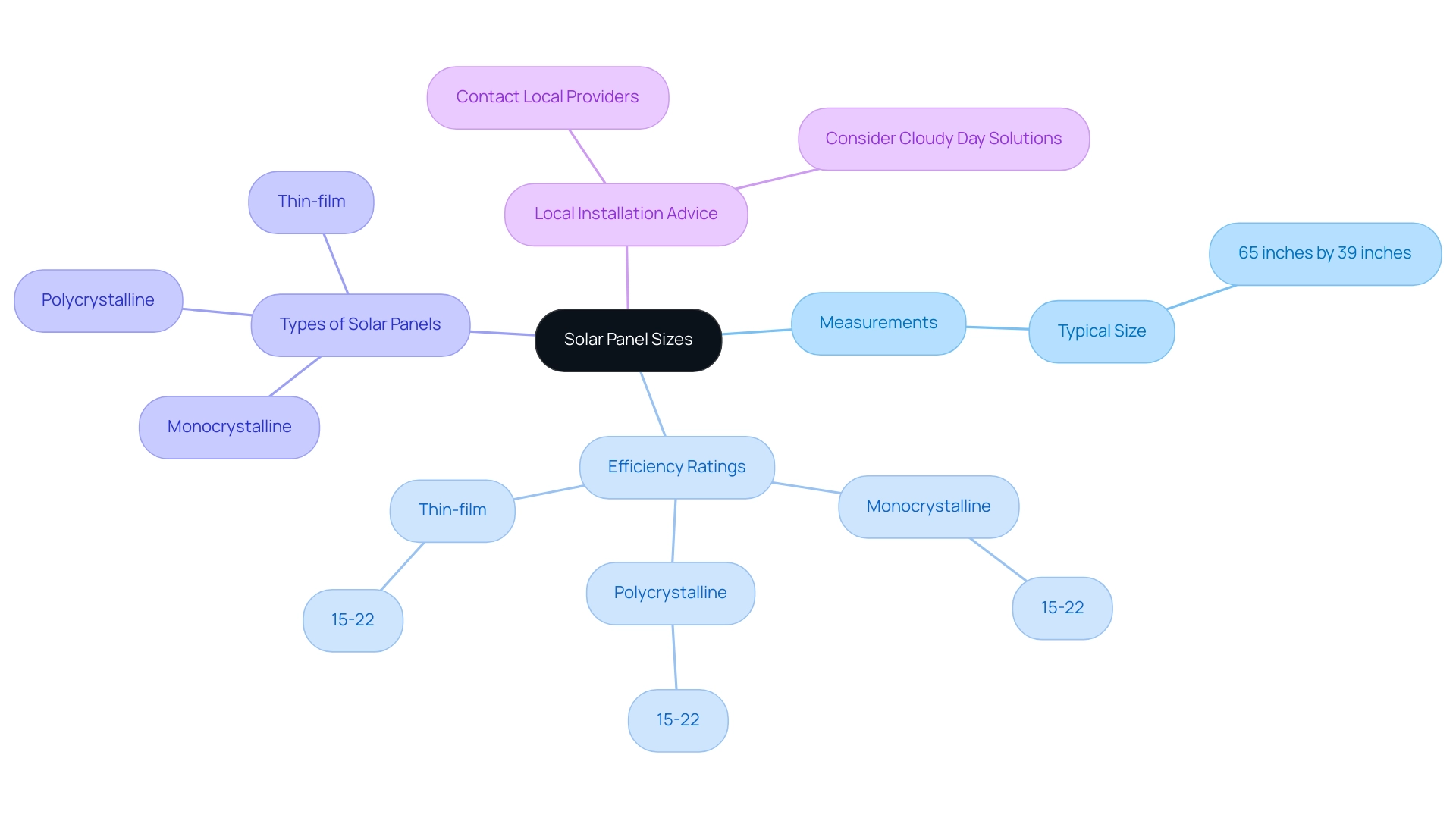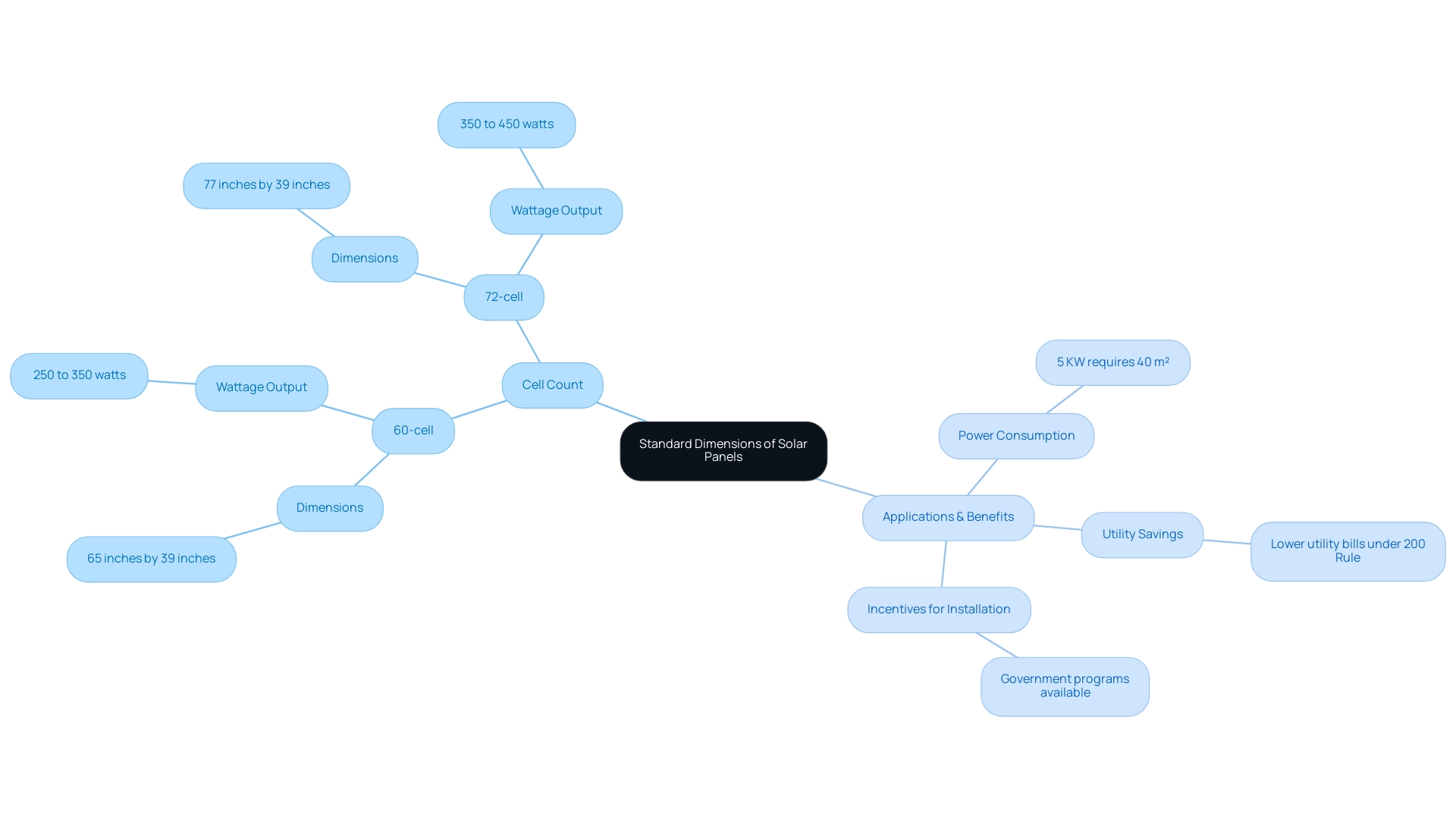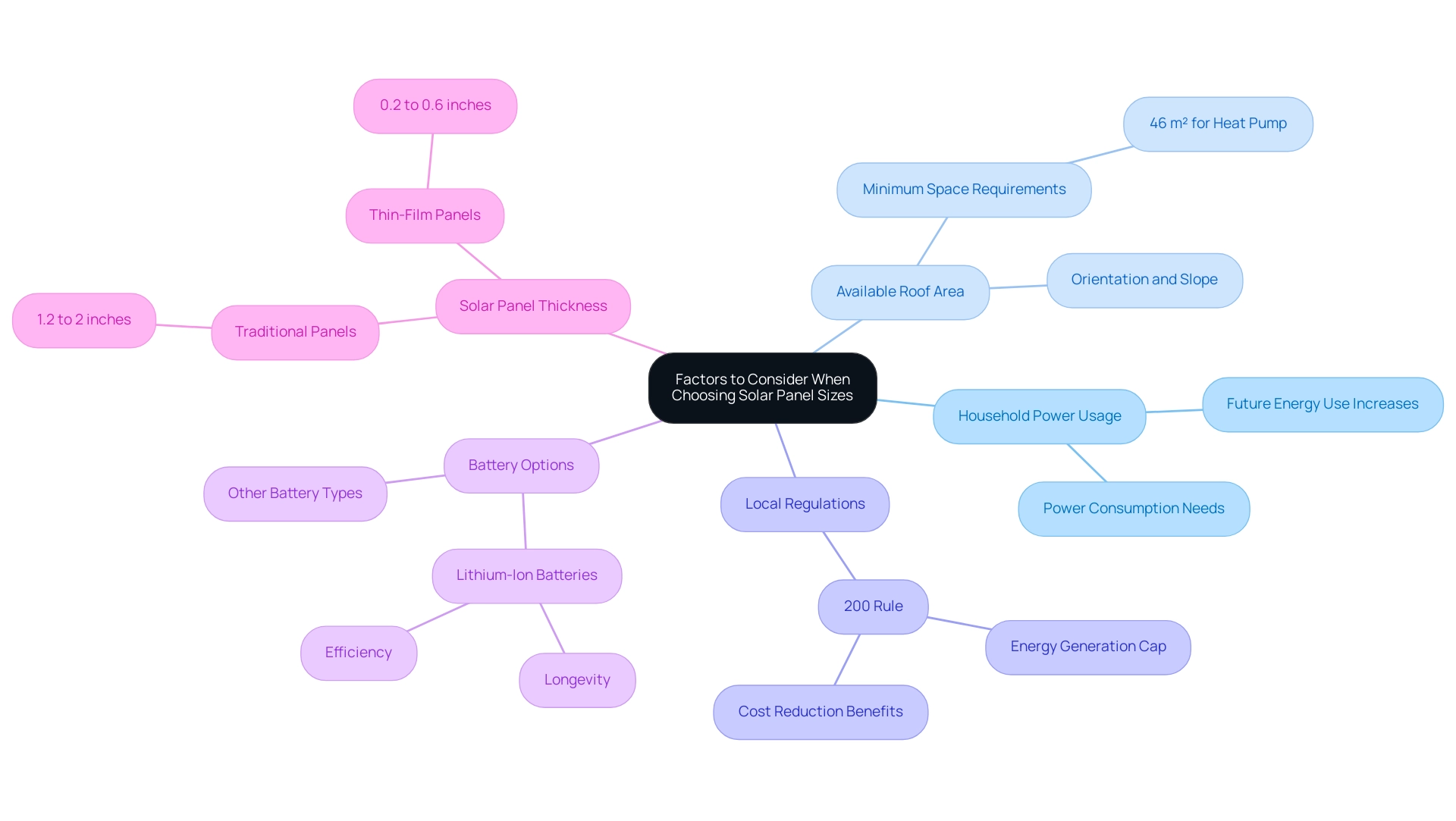Overview
The size of solar panels typically ranges from 65 inches by 39 inches for 60-cell units to approximately 77 inches by 39 inches for 72-cell units, which directly influences their power generation capabilities. The article emphasizes that understanding these dimensions, along with efficiency ratings and types of solar panels, is crucial for homeowners to effectively assess how many panels can fit their roof space and meet their energy needs, thereby optimizing their investment in renewable energy.
Introduction
As the world shifts towards sustainable energy solutions, understanding the dimensions and specifications of solar panels becomes essential for homeowners eager to harness the power of the sun. With the average residential solar panel measuring approximately 65 inches by 39 inches, the choice between different types—monocrystalline, polycrystalline, and thin-film—can significantly impact energy output and efficiency.
As interest in solar energy surges, driven by technological advancements and decreasing costs, homeowners must navigate the complexities of panel sizes to ensure their investments align with energy needs and available roof space. This exploration not only highlights the importance of selecting the right solar panel sizes but also emphasizes the broader implications for energy savings and environmental sustainability.
Understanding Solar Panel Sizes: An Overview
The measurements of photovoltaic systems are essential in assessing both power generation capability and suitability with available roof area, making this information important for environmentally aware property owners seeking to invest in renewable resources. When asking what size are solar panels, it’s typical for residential energy modules to measure around 65 inches by 39 inches, with efficiency ratings ranging from 15% to 22%, depending on the material type—monocrystalline, polycrystalline, or thin-film. This comprehension allows homeowners to evaluate how many panels can fit on their roofs, ensuring they can effectively meet their power requirements.
With a renewable project being installed every 39 seconds in 2023, interest in photovoltaic technology is swiftly growing. While the International Energy Agency estimates that the global average levelized cost of electricity (LCOE) for photovoltaic systems will be 10–15% higher in 2024 compared to 2020, advancements in PV technologies are reducing prices and improving efficiency. These enhancements render photovoltaic systems more reachable and appealing for property owners, highlighting the significance of thoroughly assessing what size are solar panels and their specifications to optimize investment in renewable resources.
Furthermore, as homeowners explore renewable energy solutions, investigating local companies in Stockton, California, can provide additional support and insights into the best options for cloudy days, ensuring a reliable energy source even during adverse weather conditions. To get started, reach out to local providers for personalized estimates and guidance on your installation journey.
Standard Dimensions of Solar Panels: What You Need to Know
When discussing what size are solar panels, standard solar modules are categorized primarily by their cell count, with the most prevalent options being 60-cell and 72-cell configurations. The measurements of these structures are important when considering what size are solar panels, with:
- 60-cell units usually measuring about 65 inches by 39 inches
- 72-cell units reaching approximately 77 inches by 39 inches
In terms of wattage:
- A 60-cell module generally yields between 250 to 350 watts
- A 72-cell system can produce between 350 to 450 watts
This distinction is essential for property owners as it directly pertains to their power requirements and the possible savings on utility expenses. To create a photovoltaic system of 5 KW, approximately 40 m² of area is necessary, which is a significant factor for installation space. By understanding these standard dimensions and their corresponding wattage outputs, environmentally aware residents can effectively determine what size are solar panels necessary to meet their power consumption needs.
Additionally, case studies have demonstrated that homeowners who installed power systems under the 200% Rule have significantly lowered their utility bills while contributing to sustainability. Various government programs offer incentives for photovoltaic installations, making it a more accessible option for many. As Velo Solar mentions, ‘Allow Velo Solar to assist your business in reducing its power expenses and its carbon footprint, while also offering you the reassurance that a photovoltaic plus storage system delivers during a grid failure.’
Improved efficiencies in contemporary photovoltaic technology, as emphasized in case studies on efficiency advancements, mean that today’s units can generate higher power outputs without increasing in size, making it easier to fit them into various residential applications. This integration of renewable energy solutions not only maximizes benefits under the 200% Rule but also supports long-term sustainability and energy efficiency for homeowners.
Exploring Different Types of Solar Panels and Their Sizes
Photovoltaic modules are classified into three main types: monocrystalline, polycrystalline, and thin-film, each having unique traits that affect their use in residential energy systems. When considering efficiency and longevity, it’s important to note that monocrystalline modules are typically around 65 inches by 39 inches, leading to the question of what size are solar panels. Their manufacturing process requires high-purity silicon, leading to a higher cost but offering better performance, especially in limited spaces.
For example, the University of Louisiana at Lafayette’s photovoltaic power facility, which has a total of 4142 modules and a capacity of 1.1 MW, demonstrates the effective use of such high-efficiency units in a real-world application. Polycrystalline modules, which are slightly larger in size, generally demonstrate lower efficiency than their monocrystalline counterparts due to their production method, which involves melting multiple silicon crystals—a process described by Sugianto from the Department of Electrical Engineering at Muslim University Indonesia:
This polycrystalline device is made from several rods of silicon crystal by melting the silicon crystal and then poured into a mold.
This leads to the question of what size are solar panels, as their dimensions can affect efficiency. A case study emphasizes that although monocrystalline modules are pricier, they provide superior efficiency in comparison to polycrystalline units, making the elevated upfront expense a compromise for enhanced performance.
Thin-film modules, on the other hand, offer a more flexible choice and can vary significantly in what size are solar panels, adapting to diverse installation needs. However, they are typically the most costly among the three types, despite their flexibility. When selecting photovoltaic modules, property owners must also think about how these systems can enhance either active or passive heating techniques to improve overall autonomy and sustainability.
Active heating systems utilize pumps and controls to circulate heat transfer fluids, making them suitable for homes requiring consistent heating, while passive systems rely on building design—like south-facing windows and thermal mass walls—to optimize heat absorption without mechanical devices. By comprehending the advantages and flexibility of each type of photovoltaic module alongside their heating systems, including the expenses and benefits of each method, eco-conscious homeowners can make informed choices that align with their power requirements and budget considerations.
Factors to Consider When Choosing Solar Panel Sizes
Choosing the suitable photovoltaic module dimensions requires a thorough evaluation of various elements, including:
- What size are solar panels
- Household power usage
- Available roof area
- Adherence to local laws
For instance, residences with increased power requirements may require a larger quantity of modules or those with higher capacities to effectively satisfy their consumption needs. Comprehending the operation of photovoltaic systems, including the best methods for choosing inverters and ideal battery selections, is essential for maximizing power advantages.
The top battery options, like lithium-ion batteries for their efficiency and longevity, should also be taken into account to improve power storage capabilities. The orientation and slope of the roof play critical roles in determining the optimal number of modules that can be installed while maximizing sunlight exposure. A well-structured photovoltaic system should strive to produce power that closely aligns with usage, as illustrated in case studies showing how residents have gained under the 200% rule.
This regulation enables property owners to set up photovoltaic systems that can generate up to 200% of their energy requirements, offering a cushion for future energy use rises and lowering expenses. Furthermore, the minimum necessary space for photovoltaic systems with a heat pump is roughly 46 m², which homeowners ought to take into account when organizing their installation. The thickness of photovoltaic modules varies, prompting the question of what size are solar panels, with conventional units measuring between 1.2 to 2 inches thick and thin-film types ranging from 0.2 to 0.6 inches thick.
As Andrew Giermak appropriately observes, ‘When figuring out how many photovoltaic units you require, it’s essential to begin with your objectives and the reasons you wish to utilize renewable energy in the first place.’ By understanding these elements, homeowners can maximize power generation and improve the overall performance of their installation, contributing positively to their sustainability efforts while preparing for future advancements in technology.
The Impact of Solar Panel Size on Energy Output and Efficiency
Understanding what size are solar panels is crucial, as the dimensions of solar modules play a significant role in influencing their power production and overall effectiveness. When considering power generation, it’s important to ask what size are solar panels, as bigger modules, like those with 72 cells, can absorb a large quantity of sunlight compared to typical 60-cell units. This is supported by the case study titled “Matching Dimensions with Desired Electricity Output,” which illustrates that larger commercial units yield higher wattage and electricity output than their residential counterparts.
This makes 72-cell structures particularly advantageous for households with higher energy demands. However, it’s essential to recognize that efficiency is influenced by several factors, including:
- The quality of the modules themselves
- Their angle of installation
- The maintenance they receive
For instance, airborne dust can diminish photovoltaic systems’ performance by as much as 65.8%, underscoring the importance of regular professional cleaning services that enhance efficiency by ensuring optimal sunlight absorption.
Professional cleaners possess specialized tools and expertise, allowing them to clean surfaces safely and effectively, preventing potential damage. Such upkeep not only enhances power generation but also prolongs the durability of the devices by preventing problems like rust and accumulation, which can reduce efficiency over time. Moreover, neglecting maintenance can lead to greater dependence on grid power, ultimately increasing your carbon footprint.
Homeowners should consider the long-term performance expectations, as the power warranty guarantees:
- 90% of initial power output after 10 years
- 80% after 25 years
Recent advancements in warranty coverage, such as those provided by SunPower, which guarantees only 92% degradation after 25 years, compared to Trina’s 80%, further illustrate the benefits of investing in larger systems for sustained efficiency over time. Integrating cutting-edge technologies such as automated cleaning robots and self-cleaning coatings can also improve the sustainability and effectiveness of renewable systems, making them an intelligent option for environmentally aware homeowners.
These technologies not only lessen the maintenance load but also aid in overall environmental sustainability by ensuring that photovoltaic systems function at optimal performance.
How to Measure and Calculate the Right Solar Panel Size for Your Home
To determine what size are solar panels suitable for your residence, start by assessing your average monthly electricity usage, usually represented in kilowatt-hours (kWh). For instance, if a household uses around 900 kWh each month, this figure is crucial for your calculations. Next, consider the average sunlight hours available in your region.
By dividing your monthly energy use by the average daily sun hours your location receives, you can ascertain the total wattage capacity needed. For instance, with a monthly usage of 900 kWh and an average of 5 sun hours daily, you would need roughly 6,000 watts of power capacity. This figure tells you how many energy collectors you would require, based on their individual wattage output, which helps you understand what size are solar panels.
Comprehending what size are solar panels is crucial for environmentally aware property owners, particularly as they aim to lower utility expenses and ecological footprint. Recent data indicates that residential households represent approximately 11.8% of total power consumption in the United States, with electricity usage growing significantly over the decades. As Tony Mariotti states, ‘Considering the power consumed by residences directly and the electricity acquired by homeowners, residential households represent approximately 11.8% of the total power consumption in the U.S.’ Practical measures such as upgrading to energy-efficient appliances, enhancing insulation, and employing smart technology to monitor and manage power usage can support array sizing efforts and improve overall efficiency.
Furthermore, insights into optimal battery selections, such as lithium-ion batteries for their efficiency and longevity, and panel inverters, which convert the generated DC electricity to usable AC power, are essential to maximize the benefits of your renewable power system. For Long Beach tenants, investigating community power initiatives can offer access to renewable solutions without the requirement for rooftop setups. Historical context is also significant; residential electricity consumption surged from 0.1 trillion kWh in 1950 to 1.5 trillion kWh in 2022, highlighting the increasing importance of efficiency and sustainable practices in homes.
Maximizing Your Investment: The Benefits of Choosing the Right Solar Panel Size
Choosing the suitable dimensions for photovoltaic units is crucial for maximizing your investment, particularly regarding what size are solar panels, as it directly affects power generation and total cost reductions. Eco-conscious homeowners who select systems tailored to their specific energy needs can experience reductions in their electricity expenses by as much as 50%. This substantial decrease underscores the financial impact of proper system sizing.
According to Fenice Energy, ‘We offer strong, affordable, and green options in India,’ while emphasizing what size are solar panels and the significance of choosing the appropriate panel dimensions. Furthermore, utilizing available incentives and rebates can greatly increase the economic advantages linked to photovoltaic installations, making it vital for property owners to comprehend how these incentives can enhance their financial results. The average expense per watt for photovoltaic systems in the U.S. is $2.56/W, offering a comprehensive financial context for potential investments in renewable energy.
Fenice Energy aids clients in maneuvering through the complexities of size selection, efficiency, and cost, allowing property owners to make informed choices that not only improve their financial results but also support a sustainable future. When evaluating renewable power expenses against conventional electricity, property owners can discover that it frequently results in long-term savings, particularly in sunny areas such as Southern California. Additionally, for tenants in Long Beach, investigating renewable options can offer access to environmentally friendly power solutions without the burden of high initial expenses.
As the residential solar market continues to evolve, the potential for widespread adoption of solar technology and significant economic growth remains promising, especially as homeowners consider integrating EV charging solutions with their solar installations, maximizing both energy efficiency and savings.
Conclusion
Understanding the dimensions and types of solar panels is crucial for homeowners looking to invest in renewable energy. The article emphasizes that choosing the right solar panel size not only affects energy output and efficiency but also directly influences installation costs and potential savings on electricity bills. With options ranging from monocrystalline to polycrystalline and thin-film panels, each type presents unique advantages, depending on individual energy needs and available roof space.
Moreover, the importance of considering factors like household energy consumption, local solar incentives, and panel maintenance cannot be overstated. Homeowners are encouraged to assess their monthly energy usage and the average sunlight their location receives to effectively calculate the required solar capacity. By doing so, they can ensure their solar investment aligns with their long-term sustainability goals and energy efficiency aspirations.
As the solar market expands and technology continues to advance, the opportunity for homeowners to harness solar energy becomes more accessible and economically viable. The growing trend toward sustainable energy solutions not only promises significant savings but also contributes positively to environmental sustainability. Embracing solar energy is not just a personal investment; it represents a collective step towards a greener future for all.





